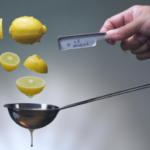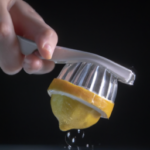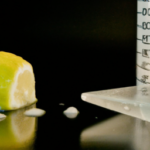So, you’re thinking about using an electric juicer to extract juice from a lemon? How clever of you! Why bother with hand squeezing when a machine can do it effortlessly? I understand – there are times when you need freshly squeezed lemon juice for your beverages, dressings, or marinades, and an electric juicer can certainly streamline the process.
So, let me guide you through the steps of juicing a lemon with an electric juicer like a pro.
First things first, let’s make sure you have the right electric juicer for the job. Not all juicers are created equal, and some may not be suitable for juicing lemons. You want to look for a juicer that has a citrus attachment or cone, as this will help you extract the most juice from your lemons.
Once you have your juicer ready, it’s time to get your lemons washed and prepped for juicing. Trust me, you don’t want any dirt or bacteria in your lemon juice – that’s just gross.
So let’s get started!
Key Takeaways
- An electric juicer with a citrus attachment or cone saves time and energy compared to manual squeezing.
- Cutting lemons evenly and placing halved lemons in the juicer ensures every last drop of juice is extracted and eliminates any seeds or pulp.
- Straining the juice to remove pulp and seeds is important for various uses, and storing the juice in the fridge for up to a week or freezing remaining lemon halves for later use is recommended.
- Cleaning the electric juicer regularly with warm, soapy water and a cleaning solution specifically designed for electric juicers ensures its longevity and prevents any unwanted buildup or residue.
Choose the Right Electric Juicer
If you’re looking to make juicing lemons a breeze, it’s important to pick the right electric juicer for the job!
There are various types of electric juicers available in the market, but not all of them are suitable for juicing lemons. One of the most popular types of juicers is a citrus juicer, which is specifically designed to juice fruits like lemons, oranges, and grapefruits.
Citrus juicers come in two types: manual and electric. Manual citrus juicers are usually cheaper and work by squeezing the fruit against a reamer with your hand.
Electric citrus juicers, on the other hand, are more expensive but more convenient to use as they require less effort. They work by pressing the fruit against a spinning reamer, which extracts the juice.
Before purchasing a citrus juicer, consider the pros and cons of each type and the price range that fits your budget. Once you’ve chosen the right juicer, it’s time to wash your lemons thoroughly.
Wash Your Lemons Thoroughly
Before starting the juicing process, it’s important to give your lemons a thorough wash to remove any dirt or residue. This is especially important if you plan to use the lemon juice for drinking purposes, such as making lemon water, as any dirt or bacteria on the surface of the lemon can contaminate the juice.
Additionally, washing the lemons will help remove any wax or pesticide residue that may be present on the skin. Aside from the health benefits of consuming lemon water, there are many other delicious ways to use freshly squeezed lemon juice in your cooking.
From salad dressings to marinades, lemon juice can add a zesty and refreshing flavor to any dish. Some popular lemon juice recipe ideas include lemon garlic chicken, lemon vinaigrette, and lemon herb roasted potatoes. With just a few simple ingredients and some freshly squeezed lemon juice, you can add a burst of flavor to any meal.
Now that your lemons are washed and ready to go, the next step is to cut them in half.
Cut the Lemons in Half
Now that you’ve got your washed lemons ready, it’s time to cut them in half to extract all that tangy goodness. Before diving in, let’s talk about the benefits of using an electric juicer. Not only does it save time and energy, but it also ensures that you get every last drop of juice from your lemons. Plus, it helps to eliminate any seeds or pulp that may end up in your drink. Trust me, investing in an electric juicer is well worth it in the long run.
When cutting your lemons, it’s important to do so evenly to ensure that you get the most juice out of each half. I recommend using a sharp knife and cutting the lemons in half lengthwise. Here are some additional tips for cutting lemons evenly:
| Tip | Explanation |
|---|---|
| Use a cutting board | This will allow you to cut straight and avoid any accidental slips. |
| Cut off the ends first | This will create a flat surface for your lemon to rest on while you cut it in half. |
| Apply even pressure | Use the palm of your hand to apply even pressure while cutting, ensuring that each half is the same size. |
| Use a citrus reamer | If you want to get every last bit of juice, use a citrus reamer to extract the remaining juice from the flesh. |
Now that you’ve got your lemons cut in half, it’s time to prepare the juicer for the next step.
Prepare the Juicer
Once you have your halved lemons, it’s time to get your trusty fruit-squeezing machine ready to work its magic. Before you start juicing, make sure your electric juicer is clean and well-maintained.
Here are some steps to prepare your juicer:
-
Check the juicer blades and make sure they’re sharp and not dull. Dull blades will make it harder to juice the lemons and may result in less juice.
-
Clean the juicer thoroughly before use. Make sure all parts are washed and dried properly to avoid any contamination.
-
Consider using alternative citrus fruits such as limes or oranges to create different flavors of juice.
Now that your juicer is ready to go, it’s time to place the lemon halves in the juicer and let the machine do its job.
Place the Lemon Halves in the Juicer
Simply grab your halved citrus and drop them into the waiting machine, letting it crush and squeeze the flavorful liquid from the fruit. It’s important to note that electric juicers are not the only option for juicing lemons. A manual juicer or even a simple fork and hand-squeezing can also get the job done. However, electric juicers are a convenient and efficient way to extract juice quickly and with minimal effort. When learning **how to juice a lemon**, it’s helpful to experiment with different tools to find what works best for you, depending on how much juice you need and how frequently you juice. Whether you’re pressing a few lemons for a recipe or juicing in larger quantities, you can adjust your method based on convenience and efficiency. No matter the technique, the bright, tangy flavor of freshly squeezed lemon juice can elevate countless dishes and drinks.
Once the lemon halves are in the juicer, the machine will do the work for you. The juice will be collected in a container or pitcher, ready to be used in any number of recipes. Lemon juice can add a zesty flavor to dressings, marinades, sauces, and more. With the juicing process complete, it’s time to move on to the next step and turn on the juicer to extract every last drop of juice.
Turn on the Juicer
To activate the juicer and get the most out of your citrus, it’s crucial to hit the power button and let the machine work its magic. However, before you turn on the juicer, make sure that it’s properly assembled and all parts are tightly secured. Otherwise, you may encounter problems such as the machine not turning on or the juice not coming out smoothly.
Here are some tips on how to troubleshoot common issues with electric juicers:
- If the machine isn’t turning on, check if it’s properly plugged in and if the power outlet’s working.
- If the juice isn’t coming out smoothly, try adjusting the pressure you apply on the lemon halves.
- If the pulp’s coming out with the juice, adjust the pulp control settings or use a strainer to separate the pulp from the juice.
Using an electric juicer for juicing fruits and vegetables has several benefits. It saves time and energy compared to manually squeezing lemons. It also allows you to extract more juice from the fruit and separate it from the pulp easily.
With these benefits in mind, let’s move on to the next step of the process: collecting the lemon juice.
Collect the Lemon Juice
Now that the lemon juice is ready, it’s time to collect it. I usually use a container with a spout for easy pouring.
Once I’ve collected all the juice, I like to strain it to remove any pulp and seeds that may have snuck in. This ensures a smooth and clean juice for whatever recipe I’m using it in.
Use a Container to Collect the Juice
Once the lemon is securely in the electric juicer, you’ll want to position a container underneath the spout to catch all of the freshly squeezed juice. Using a container has many benefits when juicing with an electric juicer.
Firstly, it allows for easy collection and transfer of the juice into other containers for storage or creative serving suggestions. Secondly, using a container ensures that the juice is not wasted and can be measured accurately for recipes.
When choosing a container, it’s important to consider the size and shape of the spout on your electric juicer. A container with a spout that matches the shape and size of the juicer’s spout will prevent any spills or messes while juicing. Additionally, a container with clear measurements will make it easier to measure the exact amount of juice needed for recipes.
Once the juice has been collected in the container, it’s time to move on to the next step of straining the juice to remove pulp and seeds.
Strain the Juice to Remove Pulp and Seeds
After collecting all the freshly squeezed juice in a container, it’s time to strain it to get rid of any unwanted pulp and seeds. This step is crucial if you want to use the lemon juice in various ways without drinking it.
One way to use the juice is by adding it to salad dressings, marinades, and sauces. Another creative recipe using lemon juice is to mix it with honey and hot water to make a soothing drink.
To strain the juice, I usually use a fine mesh strainer or cheesecloth. Place the strainer over a bowl and slowly pour the juice through it, using a spoon to press the pulp against the strainer to extract more juice. Once all the juice has been strained, discard the pulp and seeds.
Now that the juice is ready, you can store it in the fridge for up to a week. But before you do that, let’s talk about how to store the remaining lemon halves.
Store the Remaining Lemon Halves
Don’t let those precious lemon halves go to waste, squeeze every last drop out with your electric juicer or risk missing out on the most delicious lemonade you’ve ever had! Once you’ve extracted all the juice from your lemons, it’s time to store the remaining halves.
There are a few creative storage solutions to choose from, depending on your needs.
If you plan on using the remaining lemon halves soon, simply wrap them tightly in plastic wrap or aluminum foil and store them in the fridge. This will keep them fresh and ready to use for lemon recipes like lemon butter, lemon chicken, or lemon vinaigrette.
If you don’t plan on using them right away, you can also freeze them for later use. Simply place them in a freezer bag and pop them in the freezer. Frozen lemon halves are great for adding to water, tea, or cocktails for a refreshing burst of flavor.
Now that you’ve stored your lemon halves, it’s time to clean your electric juicer.
Clean the Juicer
Now that you’ve stored the remaining lemon halves, it’s time to clean the electric juicer. It’s important to maintain your juicer to ensure its longevity and prevent any unwanted buildup or residue.
Here are some tips for maintaining your electric juicer:
- First, always unplug the juicer before cleaning it.
- Then, disassemble the juicer and wash the parts with warm, soapy water.
- For tough stains or buildup, you can use a cleaning solution specifically designed for electric juicers.
- Be sure to rinse all the parts thoroughly and dry them completely before reassembling the juicer.
Cleaning your electric juicer regularly not only keeps it in good condition but also ensures that there are no leftover particles or germs in the machine that can contaminate your juice.
With these simple tips, your electric juicer will be ready for your next juicing session in no time.
Now that your electric juicer is clean and ready to go, it’s time to enjoy your freshly juiced lemon juice!
Enjoy Your Freshly Juiced Lemon Juice!
You’re in for a treat as you savor the refreshing taste of your freshly made lemonade! Now that you’ve successfully juiced your lemon using an electric juicer, it’s time to enjoy the fruits of your labor. Here are some tips to make the most of your freshly juiced lemon juice:
-
Get creative with your lemon juice recipes. Lemon juice can be used in a variety of dishes, from marinades to salad dressings. You can also mix it with other juices or add a dash of honey for a sweeter taste.
-
Enjoy the benefits of drinking lemon juice daily. Lemon juice is rich in Vitamin C, which is essential for a healthy immune system. It also helps in digestion, detoxification, and weight loss. So, make sure to incorporate it into your daily routine for a healthier lifestyle.
-
Store your lemon juice properly. Freshly juiced lemon juice can be stored in an airtight container in the fridge for up to a week. Make sure to label it with the date you made it to ensure its freshness.
With these tips, you can now enjoy your freshly juiced lemon juice to the fullest. So, go ahead and take a sip of that zesty goodness and reap the benefits of this delicious citrus fruit.
Frequently Asked Questions
Can you use an electric juicer for other citrus fruits besides lemons?
As the saying goes, "when life gives you oranges, make orange juice."And with an electric juicer, it’s a breeze. The benefits of using one for citrus fruits include easy cleanup and maximum juice extraction.
What is the best way to store freshly juiced lemon juice?
To properly store freshly juiced lemon juice, transfer it to an airtight container and refrigerate for up to 5 days. Use the juice in recipes such as salad dressings, marinades, and cocktails for added flavor and acidity.
How much lemon juice can you expect to get from one lemon?
I typically get about 2-3 tablespoons of lemon juice from one lemon. Lemon juice is a versatile ingredient with numerous Benefits of Lemon Juice and can be used in a variety of Lemon Juice Recipes for cooking, baking, and cocktails.
Is it necessary to remove the seeds from the lemon halves before juicing them?
Removing lemon seeds is crucial for seedless juice. Not only do they affect the taste, but they can also clog up the juicer. So, take the extra few seconds to remove them before juicing for a smoother and more enjoyable result.
Can an electric juicer be used to juice other fruits and vegetables besides lemons?
Yes, an electric juicer can be used to juice a variety of fruits and vegetables including apples, carrots, and beets. It’s also great for juicing leafy greens like kale and spinach. Experiment with different combinations for delicious and nutritious drinks.
Conclusion
Well, that’s it! Juicing a lemon has never been easier with the help of an electric juicer.
It’s like having a trusty tool in your toolbox that makes your life easier. Just like how a carpenter wouldn’t be caught without his trusty hammer, a kitchen aficionado wouldn’t be caught without his electric juicer.
It’s amazing how something so simple can bring so much joy and flavor to our lives. With just a few simple steps, you can enjoy the freshest and tastiest lemon juice in the comfort of your own home.
So go ahead, get your hands on an electric juicer, and start juicing those lemons! Your taste buds will thank you.
Susannah expertise lies in researching and compiling evidence-based content on juicing, nutrition, and overall health. She is committed to ensuring that The Juicery World offers accurate, up-to-date, and trustworthy information to empower readers to take control of their health. Susannah’s goal is to inspire individuals to embrace juicing as a way to nourish their bodies and live their best lives.

















